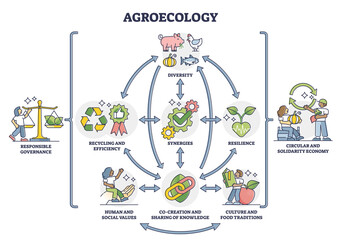Agroecology and regenerative agriculture represent holistic approaches to farming that prioritize environmental sustainability, biodiversity conservation, and soil health. These approaches aim to work in harmony with natural ecosystems, minimize external inputs, and build resilience to climate change. Here, we’ll delve into the principles of agroecology and regenerative agriculture and explore their potential to transform the way we produce food.
1. Principles of Agroecology:
Agroecology integrates ecological principles and traditional knowledge with modern science to design farming systems that are diverse, resilient, and environmentally sustainable. Key principles include:
- Biodiversity: Promoting the diversity of crops, livestock, and beneficial organisms to enhance ecosystem resilience and productivity.
- Soil Health: Improving soil fertility, structure, and biodiversity through practices such as cover cropping, crop rotation, and organic matter management.
- Ecological Pest Management: Using natural enemies, crop diversification, and cultural practices to control pests and diseases without relying on chemical pesticides.
- Agroforestry: Integrating trees and woody perennials into agricultural landscapes to provide multiple benefits such as soil conservation, carbon sequestration, and habitat for wildlife.
- Social Equity: Ensuring that agricultural systems are socially and economically equitable, empowering farmers and communities to participate in decision-making and benefit from the fruits of their labor.
2. Principles of Regenerative Agriculture:
Regenerative agriculture takes a holistic approach to farming that seeks to restore and enhance the health of agroecosystems over time. Key principles include:
- Soil Regeneration: Building soil organic matter, microbial diversity, and soil structure through practices such as no-till farming, cover cropping, and compost application.
- Carbon Sequestration: Enhancing carbon storage in soils and biomass to mitigate climate change and improve soil fertility and water retention.
- Water Management: Conserving water resources through techniques such as rainwater harvesting, soil conservation, and efficient irrigation practices.
- Biodiversity Enhancement: Creating habitat for diverse plant and animal species, including pollinators and beneficial insects, to support ecosystem services and natural pest control.
- Collaboration and Knowledge Sharing: Fostering collaboration among farmers, researchers, and communities to share knowledge, innovation, and best practices for regenerative agriculture.
3. Benefits of Agroecology and Regenerative Agriculture:
Agroecology and regenerative agriculture offer numerous benefits for farmers, consumers, and the environment, including:
- Improved Soil Health: Enhancing soil fertility, structure, and resilience to erosion and drought.
- Climate Resilience: Mitigating climate change impacts through carbon sequestration, water conservation, and enhanced ecosystem resilience.
- Biodiversity Conservation: Preserving and restoring biodiversity in agricultural landscapes, supporting ecosystem services and wildlife habitat.
- Sustainable Livelihoods: Empowering farmers and communities with diversified, resilient farming systems that provide food security, income, and cultural continuity.
- Healthier Food: Producing nutritious, chemical-free food that nourishes people and promotes human health and well-being.
4. Scaling Up and Mainstreaming Agroecology and Regenerative Agriculture:
Scaling up agroecology and regenerative agriculture requires supportive policies, investment in research and extension services, and capacity building for farmers and communities. Governments, international organizations, and civil society play crucial roles in mainstreaming these approaches through:
- Developing policies and incentives that support agroecological and regenerative practices, such as subsidies for organic farming, agroforestry incentives, and payments for ecosystem services.
- Investing in research, education, and technical assistance to develop and disseminate agroecological and regenerative farming methods tailored to local contexts.
- Strengthening farmer organizations, cooperatives, and extension services to facilitate knowledge exchange, peer learning, and collective action among farmers.
In conclusion, agroecology and regenerative agriculture offer promising pathways to transform agriculture and build more sustainable, resilient food systems. By embracing these approaches and supporting farmers and communities in their adoption, we can cultivate a future where food production nourishes people, restores ecosystems, and sustains livelihoods for generations to come.
Stay tuned for our next exploration into another critical topic shaping the future of agriculture and sustainable food systems.
